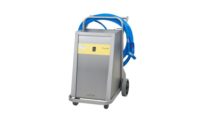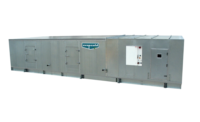The new Low Charge Central System (LCCS) from Frick Industrial Refrigeration is a reliable, high efficiency central refrigeration system with a total system ammonia charge of approximately 1.5 to 3 pounds per ton of refrigeration, or 85 to 95 percent less than traditional central ammonia systems.
The LCCS is the only centralized system in the super-low charge category (less than 5 lbs/TR).
“Among super-low charge refrigeration systems, our new LCCS offers enhanced reliability and efficiency,” says Joseph Pillis, P.E., Frick’s director of engineering, Industrial Refrigeration. “And its flexibility allows it to be customized to any plant’s specific refrigeration needs.”
This reduction in refrigerant charge may enhance the safety of food and beverage plant personnel and people living or working in the vicinity of a plant. In addition, the low charge can in some cases ease the regulatory burden and compliance costs for facilities.
The system’s driving innovation is localized condensing made possible via remote distributed condensing (RDC) units that are managed by Frick’s patent-pending control system. Instead of feeding centrally condensed liquid ammonia through the system, only ammonia vapor is distributed through the plant. It is then condensed locally, near the evaporators.
The RDC units, which include a condensing heat exchanger (adiabatic, plate & frame, air-cooled or evaporative) and a small liquid supply vessel, are placed near DX evaporators, at the point of liquid use.
As a result of the RDC units, the new system eliminates centralized condensers, the high-pressure receiver and large, long supply and return lines full of pumped liquid.
According to Pillis, “Frick’s proprietary, state-of-the-art controls monitor and control liquid levels to make sure we don’t run out of liquid in places where it’s needed.”
The modular nature of each RDC and associated evaporators makes the Frick LCCS system extremely flexible in design and installation, both for greenfield projects and existing plant expansions.
The design of the patented Frick LCCS retains a traditional engine room, which offers the same flexibility, efficiency and familiarity as a traditional liquid recirculation system, but it contains only compressors and a control panel – no liquid ammonia storage vessels. This allows the use of larger, more efficient compressors (up to 25%) than those found in many packaged systems.
Moreover, to date, all low charge solutions have been based on providing rooftop packages, which often require costly alterations to the building structure. With Frick’s LCCS, such accommodations are generally not necessary: The technology can be easily retrofitted to an existing facility. And, since compressors are in the engine room and not on the roof, they can be conveniently serviced out of the elements.
Pillis concludes, “Direct and open access to key components makes it easy for inspection, test and maintenance and maximizes worker safety. The modular remote distributed condensing concept enables projects to be scalable based on the application needs.”
For additional information, please visit http://www.johnsoncontrols.com.




Report Abusive Comment